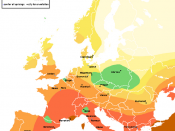The Invisible Killer
The Black Death is sometimes thought of as the worst and most devastating disease that has ever beset mankind. The plague, another name for this unforgettable catastrophe of the human race, is even used as a cliché in daily life. This momentous disease took place in medieval England, and was one of the worst natural disasters in history. Although, at the time, it may not have been known how it was being brought over, it could have been dealt with more effectively. Fewer people would have died, if more effective measures had been taken.
The outbreak location of the Black Death has numerous possibilities. The first recorded occurrence was in the early 1300s when it swept through China, cutting its population in half (Daniels, Hylslop 24). The Black Death probably struck earlier in Asia or Africa centuries earlier, but left no record of its casualties or detailed information (Blainey 191).
From the records that are known, it was brought to China no earlier than 1331 (McNeill 175). After the plague arrived in China, it must have traveled the caravan routes of Asia during the next fifteen years (McNeill 175). This is how the infectious disease began to establish itself.
The plague traveled quickly, and spread at an inconceivable rate. Rats from China, carrying infected fleas, traveled overseas through the Middle East to Sicily in 1347 (Daniels, Hylslop 24). As these caravans traveled far and wide and came in contact with more men and more animals, the disease continued to spread more and more rapidly (McNeill 175). Sometimes when ships would arrive in Sicily that had carried the plague, many men on the ship had already died ("Bubonic"). During the winter when the disease was brought over, it seemed to disappear, but that was only because...


